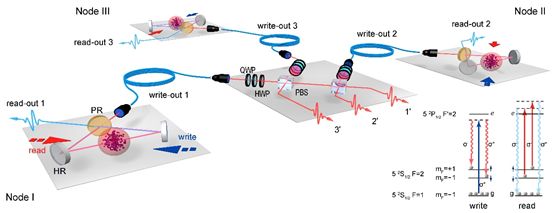Prof. PAN Jianwei and Prof. BAO xiaohui at USTC successfully realized the entanglement of three remote atomic-ensemble quantum memories via interference of three single photons, which paves a way towards long-distance quantum networks and multi-party quantum communication. This breakthrough study was published in Nature Photonics on January 21st and was praised by the reviewer as a milestone for multi-party quantum networks.
As an intermediate stage of quantum internet development, quantum memory networks are distinguished by the capability of the end nodes to have local memory while simultaneously allowing universal local control. This will enable a number of significant applications such as quantum teleportation and distributed quantum computing.
The most promising approach to build quantum networks is using an architecture combining photons as flying qubits with stationary matter-based quantum memories. A crucial requirement for the matter system is the ability to entangle with photons efficiently. To improve the efficiency, Prof. PAN and Prof. BAO's group make use of a ring cavity to enhance the light-matter interaction and manage to use the ring cavity itself as a frequency filter to eliminate noise photons, which avoids unwanted losses comparing to frequently-used external frequency filters. In addition, they use a Hermite-Gaussian mode for the cavity locking beam, which reduces its leakage into the single-photon channels significantly.

Experiment layout(Image from Nature Photonics)
By harnessing the high-performance light-matter interface (Nat. Photon. 10, 381, 2016) and Rydberg blockade (Phys. Rev. Lett. 117, 180501, 2016), the node number can hopefully be further increased. Extension of distances for memory separations can be realized by converting photon wavelength to the telecom band and using low-loss fibre for transmission.
This work was supported by National Key R&D Program of China, Anhui Initiative in Quantum Information Technologies, National Natural Science Foundation of China and the Chinese Academy of Sciences.
(Written by YANG Ziyi,edited by WU Qiran, USTC News Center)
References:
Nature Photonics (2019): Entanglement of three quantum memories via interference of three single photons
https://www.nature.com/articles/s41566-018-0342-x